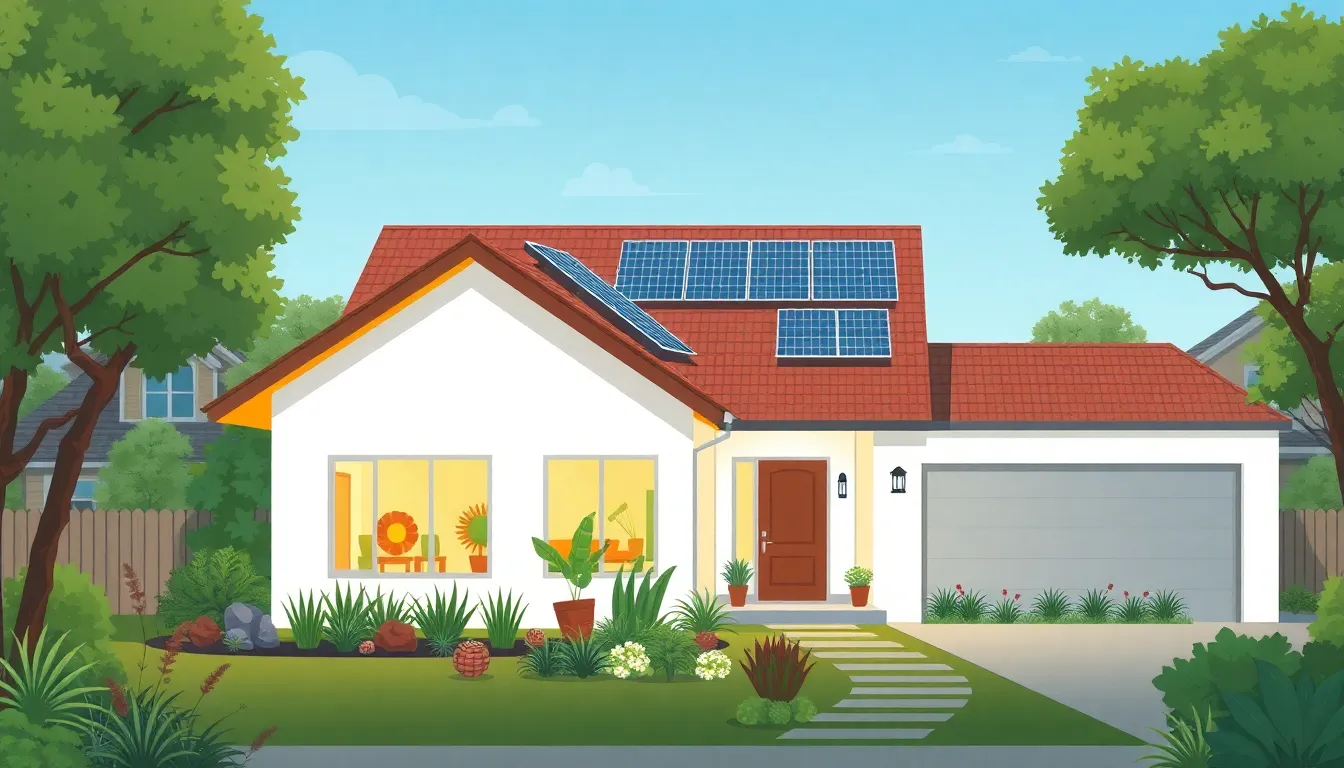Imagine living in a home that not only makes your life easier but also saves the planet. That’s the magic of sustainable smart homes. These eco-friendly havens combine cutting-edge technology with energy-efficient designs, turning everyday living into a guilt-free experience. Who knew saving the Earth could be so chic?
From smart thermostats that know when you’re too hot to handle to solar panels that practically pay for themselves, sustainable smart homes are like the superheroes of the housing world. They’re here to rescue you from high energy bills and the dreaded carbon footprint. So why not join the green revolution? It’s time to embrace a lifestyle that’s as smart as it is sustainable.
Table of Contents
ToggleOverview of Sustainable Smart Homes
Sustainable smart homes combine technology and eco-friendly practices to create efficient living spaces. Advanced systems, such as smart thermostats, allow homeowners to control their energy consumption with precision. Energy-efficient designs contribute significantly to reduced utility costs, providing both comfort and savings.
Integrating solar panels into these homes produces renewable energy, further lowering dependence on non-renewable sources. Smart lighting systems adjust based on occupancy, minimizing energy waste. Water-efficient appliances enhance sustainability while maintaining functionality.
Smart home networks offer convenience by enabling automation for various systems. They can optimize energy use based on real-time data and user preferences, leading to substantial environmental benefits. Homeowners can track their energy usage through mobile applications, allowing for informed decisions.
Sustainable materials are often used in the construction of smart homes. These materials reduce environmental impact and promote healthier indoor air quality. Utilizing recycled or locally sourced materials enhances the sustainability of the building process.
The adoption of sustainable smart homes encourages a lifestyle that prioritizes both ecological responsibility and technological advancement. Homeowners enjoy the blend of innovation and environmental consciousness, creating spaces that support a healthier planet. In this way, sustainable smart homes represent not just a trend but a vital shift toward responsible living for future generations.
Benefits of Sustainable Smart Homes

Sustainable smart homes offer numerous advantages for homeowners while promoting environmental responsibility. Two key benefits include energy efficiency and cost savings.
Energy Efficiency
Energy efficiency stands out as a primary benefit. Smart thermostats adjust heating and cooling automatically based on occupancy. Smart lighting adapts to natural light levels while responding to human presence, reducing energy waste. Solar panels produce renewable energy, lessening dependence on fossil fuels. Efficient appliances consume less water and power, contributing to reduced energy demands. Each feature works in harmony to create an optimized living environment that supports eco-friendly practices.
Cost Savings
Cost savings represent another significant benefit. Lower utility bills result from enhanced energy efficiency. Homeowners often see substantial reductions in monthly expenses as smart devices manage energy use intelligently. Over time, the investment in energy-efficient technologies pays off through reduced operating costs. Many governments offer tax incentives and rebates for sustainable home upgrades, further increasing financial benefits. Long-term savings accumulate, highlighting the economic advantages of adopting sustainable smart home solutions.
Key Features of Sustainable Smart Homes
Sustainable smart homes contain key features that promote energy efficiency and environmental responsibility. These elements contribute to a modern lifestyle while minimizing negative impacts on the planet.
Smart Technology Integration
Smart technology integration enhances home automation and energy management. Homeowners utilize smart thermostats to optimize heating and cooling, adjusting settings based on occupancy. Advanced lighting systems work in tandem, sensing natural light and adapting brightness levels. Control over energy consumption occurs through mobile apps that provide real-time data. Home security also benefits from these systems, offering remote monitoring and alerts. Overall, integration of smart technology maximizes comfort and functionality while reducing utility costs.
Eco-Friendly Materials
Eco-friendly materials play a vital role in sustainable smart home construction. Builders often choose recycled products for insulation and flooring, reducing landfill waste. Low-VOC paints, stains, and finishes promote healthier indoor air quality. Sustainable sourcing of wood and products further minimizes environmental impact. Additional materials like bamboo and reclaimed wood exemplify eco-conscious choices. By prioritizing these elements, sustainable smart homes not only lower their carbon footprint but also create inviting, healthy living spaces.
Challenges in Implementing Sustainable Smart Homes
Implementing sustainable smart homes presents various challenges. High initial costs deter many homeowners from investing in advanced technology and energy-efficient systems. This financial barrier often leads to a slow adoption rate, despite the long-term savings on utility bills.
Technical complexities arise during the integration of smart systems. Compatibility issues between devices can complicate installations and require specialized knowledge. Homeowners may find themselves overwhelmed by the technological learning curve, which hampers effective usage.
Another challenge is the need for skilled professionals. The demand for experts in sustainable technology and smart home installations often outpaces supply. Finding qualified contractors or service providers who can install and maintain these systems becomes essential.
Data privacy and security concerns plague potential users. Many smart devices collect personal information, leading to apprehension about data breaches and unauthorized access. Ensuring robust cybersecurity measures becomes crucial to alleviate these worries.
Maintenance requirements add to the challenges of sustainable smart homes. Regular updates and servicing of smart devices are necessary to keep systems functioning optimally. Homeowners need to commit time and resources to ongoing maintenance, which may discourage potential users.
Regulatory hurdles also impact implementation. Local building codes and regulations may not accommodate innovative designs or sustainable features. Navigating these legal landscapes involves significant effort and can delay projects.
Despite these challenges, many homeowners express a growing interest in sustainable living. Awareness of environmental issues drives the demand for energy-efficient homes and smart technology. This trend encourages manufacturers to innovate and create solutions that address existing barriers, paving the way for more accessible sustainable smart home options.
Future Trends in Sustainable Smart Homes
Emerging trends in sustainable smart homes focus on enhanced automation and eco-friendly technologies. Innovations in artificial intelligence streamline energy management systems, enabling devices to learn user behavior. Smart appliances, now equipped with machine learning, optimize energy use even further. Sustainability certifications for new constructions will likely become a standard requirement.
Integration of renewable energy sources continues to gain traction. Homes increasingly rely on solar panel technology, with advancements in energy storage solutions improving efficiency. The storage capacity of batteries has expanded, allowing homeowners to store energy generated during peak sunlight hours for evening use.
Homeowners also emphasize the importance of smart building materials. Materials equipped with health-monitoring features contribute to better indoor air quality. Sensors embedded in flooring and walls can detect pollutants and adjust ventilation accordingly.
More companies prioritize user-friendly interfaces in applications. Home automation systems now feature streamlined controls, making it easier for homeowners to manage energy consumption in real time. Integration with voice assistants enhances accessibility, allowing for hands-free control of various devices.
As local governments adopt incentives for sustainable living, financial support becomes more accessible. Tax credits and grants encourage residents to invest in energy-efficient upgrades. The increasing collaboration among manufacturers, contractors, and policymakers promotes a more cohesive approach to sustainable smart home initiatives.
Investors show a growing interest in green technology. Significant capital is now directed toward startups focused on developing sustainable home solutions. The market demand for such innovations continues to rise, indicating a shift toward a more eco-conscious consumer base.
These trends reflect a broader commitment to sustainability and innovation. Addressing challenges in affordable eco-friendly technology fosters a rapidly evolving landscape in sustainable smart homes.
Sustainable smart homes represent a transformative shift in how individuals approach living spaces. By merging technology with eco-friendly practices, they create environments that are not only efficient but also enhance overall quality of life. The ongoing innovations in smart technology and renewable energy sources promise to make these homes more accessible and affordable.
As awareness of environmental issues continues to grow, the demand for sustainable living solutions will likely increase. Homeowners are encouraged to embrace this trend, taking advantage of the benefits that sustainable smart homes offer. With the right investments and a commitment to eco-conscious choices, a greener future is within reach.


